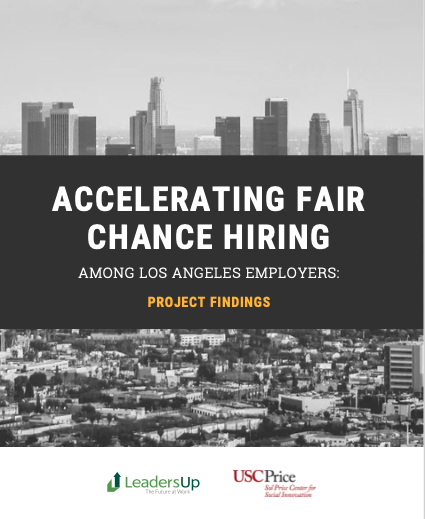 The USC Sol Price Center for Innovation and LeadersUp, an L.A.-based national nonprofit dealing with youth unemployment, have published the results of their Accelerating Fair Chance Project.
The USC Sol Price Center for Innovation and LeadersUp, an L.A.-based national nonprofit dealing with youth unemployment, have published the results of their Accelerating Fair Chance Project.
The project, launched in spring 2019, identified employer solutions to the challenge of unemployment among youth who have been in the justice system. (These solutions, however, can be applied to the unemployment of people of any age, anywhere.) It included a survey, lab sessions and engagement with employers. The end result is a report, Accelerating Fair Chance Hiring Among Los Angeles Employers: Project Findings, highlighting the findings, along with an Employer Framework that advises companies on how to identify and develop fair chance hiring strategies.
Employers surveyed on fair chance hiring
The Sol Price Center began the project by surveying 39 employers on their experience with fair chance hiring. These employers represented a broad range of sizes, from small (1-200 employees) to large (1,000+ employees), and a variety of industries, from health care and education to science and tech.
More than three-quarters of the respondents agreed that fair chance policies can benefit the economy and increase the number of qualified job applicants. Even so, an even greater number felt that hiring candidates with a criminal record is riskier than hiring those without one. The barriers they face in hiring justice-involved youth include stigma, skills-matching and a lack of understanding of justice involvement.
Employers yet to institute fair chance hiring practices
Although the employers surveyed support the idea of fair chance hiring, most have not instituted practices that carry it out:
- Only 38% of employers responding, for example, “ensure criminal record information is complete and accurate” as part of the background check process.
- And only 44% of the employers “provide an opportunity to explain conviction.”
These and other practices may indicate that the employers may not be up-to-date on fair chance hiring best practices.
The Accelerating Fair Chance Project decided to bridge the gap between the support of — and the implementation of — fair chance practices by applying Design Thinking. Design Thinking is a process that works from the ground up rather than top down.
In this case, the process involved two Innovation Labs. The first brought five employers together to discuss hiring practices and the key barriers to hiring justice-involved youth. The second involved 10 employers, who worked to develop new strategies that would expand employment opportunities for those justice-involved youth.
The challenges these employers face in expanding the hiring of justice-involved youth included:
- A lack of knowledge of criminal records and which ones are legally allowed on background checks.
- An inability to review criminal records for accuracy.
- A lack of authority to create new initiatives at the HR level.
- A need to change the wording on job postings to indicate they are open to fair chance hiring.
- The fact that job applicants from this population often lack soft skills and are not properly prepared for interviews.
Creating an employer framework
The project also included creating an Employer Framework report that serves as a guide to help employers improve their fair chance hiring practices for justice-involved youth. (Again, these can be applied to applicants of any age.)
The Employer Framework recommends the following steps to create and develop inclusive hiring strategies:
- Define objectives – the reason for adopting these strategies and what you hope to achieve.
- Determine your internal and external audiences – who within the organization needs to come on board and how to get them involved. And who are the justice-involved youth, where do you find them and how do you reach them.
- Document your hiring process, and identity talent needs and gaps.
- Determine how to move to a more inclusive hiring strategy, realizing the different approach to job seeking that justice-involved youth take. Then broaden your approach to become anti-racist, as well.
- Create actionable items to implement the strategy you’ve put together.
The Employer Framework report also includes a detailed facilitation guide to help organizations brainstorm possibilities as they strive to become fair chance employers.
Although created by Los Angeles organizations based on insight from local employers, the information can be utilized by anyone anywhere.

